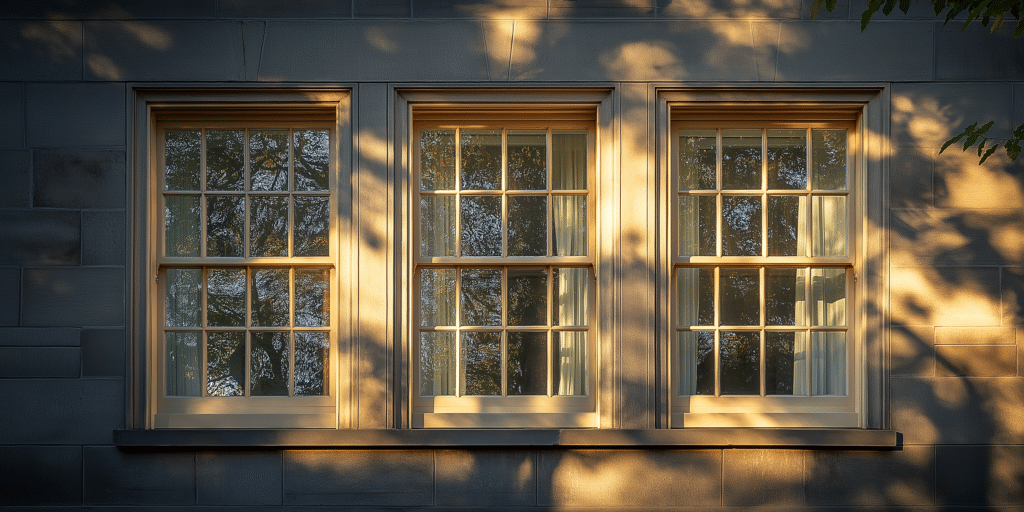What Is a Sash Window Pane Spacer?

A sash window pane spacer is a critical component of double-glazed and triple-glazed sash windows. It serves as a thermal barrier between the glass panes, not only separating them but also preventing heat transfer and condensation build-up. Without it, the energy efficiency of your windows would be severely compromised, leading to higher heating bills, reduced insulation, and an uncomfortable home environment.
The spacer creates a gap filled with an inert gas, typically argon or krypton, which enhances the window’s insulation properties. Without this separation, the panes would allow significant heat loss, making the window far less effective at controlling the indoor climate.
Key Functions of Sash Window Pane Spacers:
- Thermal Insulation: Spacers minimise thermal bridging, which occurs when heat is conducted through the window frame, reducing heat transfer between panes. Studies show that high-performance spacers, like those using warm-edge technology, can improve overall insulation by up to 65%.
- Energy Efficiency: High-quality spacers, particularly those made with warm-edge technology, can reduce energy bills by preventing unnecessary heat loss, saving up to 20% in energy costs annually.
- Condensation Control: By maintaining the correct distance between panes, spacers help reduce condensation, which is crucial for preventing mould growth and maintaining window integrity.
- Structural Stability: Misaligned or low-quality spacers can lead to window frame instability, potentially causing panes to shift or crack.
Why Are Sash Window Pane Spacers Important for Energy Efficiency?
Sash window pane spacers are pivotal in boosting a window’s energy efficiency by acting as a thermal break. The gap created by the spacer is often filled with argon, krypton, or xenon gases, which possess low thermal conductivity, meaning they reduce heat transfer.
- When properly installed in double-glazed or triple-glazed windows, sash window spacers can reduce heat loss by up to 20%, directly impacting your energy consumption and monthly bills. Using desiccants within spacers also prevents fogging and maintains insulation performance.
- It can improve energy efficiency by up to 65% compared to conventional materials. Warm-edge spacers can also help lower a window’s U-value, enhancing its thermal properties.
- The U-value measures the rate of heat transfer through the window. High-quality spacers reduce the U-value, meaning the window becomes more energy-efficient.
- Investing in high-performance spacers can result in significant savings, reducing heating and cooling costs and increasing the lifespan of your windows. With proper installation and advanced spacer materials like those incorporating krypton gas, you can enhance insulation and comfort.
What Materials Are Used for Sash Window Pane Spacers?
Spacers are made from various materials, each affecting the window’s thermal performance and durability differently. The material directly influences the window’s insulation capability and longevity.
- Aluminium Spacers: Although highly durable, they conduct heat, making them less effective in reducing heat transfer between panes. Industry research notes the lower thermal performance of aluminium spacers compared to newer materials like foam or uPVC spacers.
- uPVC Spacers: uPVC (unplasticised polyvinyl chloride) spacers are known for their excellent thermal insulation properties, offering better energy efficiency than aluminium. Window authorities suggest that uPVC spacers can dramatically lower U-values in sash windows, making them a top choice for modern energy-efficient homes.
How to Choose the Best Sash Window Pane Spacer for Your Home?

The right spacer depends on various elements, including climate, window type, and energy efficiency goals. The material significantly impacts thermal performance and the window’s longevity.
- Climate Considerations: In colder climates, selecting a spacer with high thermal performance, such as a foam or composite material, will improve heat retention and lower energy bills.
- Energy Efficiency Goals: If reducing your home’s carbon footprint is a priority, opt for spacers made of low thermal conductivity materials, such as foam or composite materials.
- Window Compatibility: Not all spacers work with every type of window. Always check whether the chosen spacer is compatible with your double-glazed or triple-glazed sash window system. Industry leaders suggest matching the spacer material with the correct glazing system can increase window longevity and performance.
- Budget Considerations: While they may cost more upfront, warm-edge spacers offer long-term energy savings, making them a smart investment for homeowners looking to reduce energy costs over time.
What Are the Benefits of Warm-Edge Technology?
Warm-edge technology refers to spacers made from low-conductivity materials such as thermoplastic or composite materials that dramatically reduce heat transfer.
- Improved Energy Efficiency: They can reduce energy loss through windows by up to 65%, making them a top choice for energy-conscious homeowners. A European Glass and Glazing Federation study highlights that warm-edge spacers can save up to 10-15% on annual energy consumption in colder climates.
- Condensation Control: By maintaining a more consistent temperature between the panes, these spacers reduce the likelihood of condensation inside the window, helping reduce moisture-related issues such as mould and rot.
- Lower U-Values: A lower U-value indicates better insulation. Warm-edge spacers help reduce U-values, improving the energy performance of your windows.
- Durability: These spacers are highly durable and less susceptible to degradation over time, ensuring the long-term performance of your sash windows. Durability tests reveal that warm-edge spacers maintain their structure for up to 20 years without losing performance.
What Are the Installation Best Practices for Sash Window Pane Spacers?
Proper installation is key to maximising the benefits of your sash window pane spacers.
- Accurate Measurement: Precise measurement of the spacers ensures a tight fit between the panes, preventing air leaks and optimising thermal insulation.
- Sealing Techniques: High-quality sealing materials must be applied to avoid moisture ingress, which can lead to condensation, mould, and reduced thermal performance.
- Avoid Over-Tightening: Over-tightening the window panes can stress the glass and reduce the overall effectiveness of the spacer, resulting in compromised thermal insulation. Experts recommend leaving a margin for expansion and contraction to maintain energy efficiency.
- Regular Inspection: Inspect spacers annually to check for wear and tear that could compromise window performance. Homeowners should watch for signs of condensation, drafts, or visual shifts in the glass panes, indicating a spacer might be compromised.
How Do Sash Window Pane Spacers Contribute to Soundproofing?

Sash window spacers reduce noise from outside sources by maintaining the correct distance between panes and using sound-insulating gases.
- The spacer’s gap between the panes acts as a barrier to sound waves, significantly reducing external noise. Industry experts confirm that larger gaps filled with argon gas enhance soundproofing properties.
- The spacer’s thickness and the gas used to fill the space determine how effective the soundproofing will be. Thicker gaps can reduce noise pollution more effectively. Noise reduction levels can vary by 10-15 decibels depending on spacer and glass combinations.
- High-performance spacers are often paired with acoustic laminated glass for maximum soundproofing, further reducing sound transmission.
- Sash window spacers designed for soundproofing are ideal for urban dwellers looking to create a quieter home environment. Those living near airports, motorways, or busy city centres can significantly benefit from upgraded spacers for noise reduction.
Conclusion: Maximising the Benefits of Sash Window Pane Spacers
Whether you aim to reduce energy consumption, improve soundproofing, or prevent condensation, choosing the right spacers will impact your home’s comfort and efficiency. Warm-edge technology or other low-conductivity materials will enhance your window’s thermal performance, reduce energy bills, and contribute to a more sustainable home.
Finally, ensuring proper installation and regular maintenance of your sash window pane spacers will guarantee that they continue to perform effectively, making your home more energy-efficient, comfortable, and soundproof for years.




